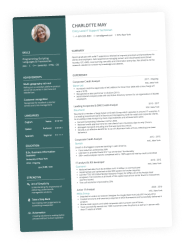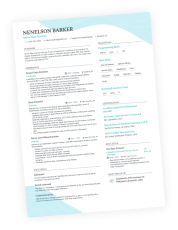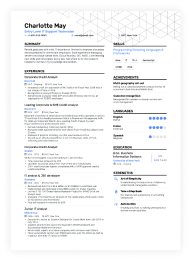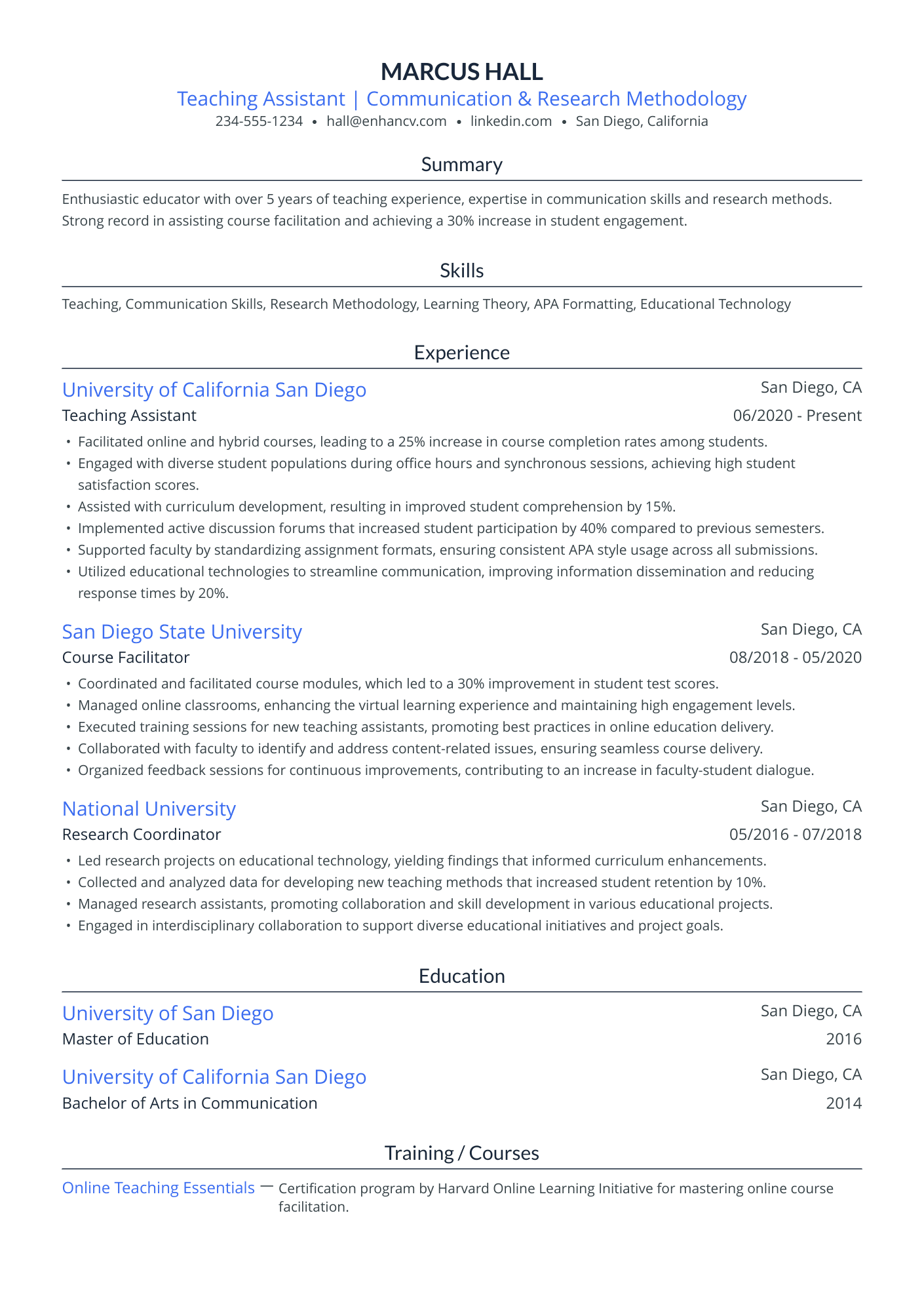“If I haven’t graduated yet, will employers even take me seriously?”
That’s the question running through your head as you fill out the education section of your resume. You know you need to list your degree—but since you haven’t actually finished it, you’re not sure how. Will an "expected graduation date" make you look unqualified? Or will leaving it off confuse recruiters?
The good news is providing your expected graduation date the right way can actually boost your chances. This guide will show you exactly how to format it, where to put it, and what mistakes to avoid—so you can feel confident hitting "submit" on your application.
Key takeaways
- Always include an expected graduation date if you’re still in school—this helps recruiters understand your qualifications and timeline.
- Use a clear, professional format, like “Expected Graduation: May 2026,” to avoid confusion and ATS issues.
- Place your education section near the top if you’re a student or recent graduate, but consider mentioning your degree in your summary if it’s a major selling point.
- Update your resume once you graduate to remove “expected” and ensure your information stays accurate.
- Avoid common mistakes like using only the graduation year, forgetting to update it, or leaving it off when applying for internships.
Why should you include an expected graduation date on your resume?
If you're still in school or recently graduated, employers want to see your degree on your resume. Not having it listed can raise questions like “Are they still studying? Did they drop out? When will they be qualified?”
Adding an anticipated graduation date clears up the confusion and shows recruiters that you’re actively working toward your degree.
It’s especially important if:
- You’re a student applying for internships or entry-level roles.
- You’re a career changer balancing work and studies.
- The job requires a specific degree, even if you haven’t finished it yet.
PRO TIP
If you’ve been in the workforce for years and already have your degree, just list the graduation year—no need to include the start date or explain the timeline.
If you haven’t finished your degree and don’t plan to, that’s trickier. You can either leave it off entirely or be ready to address it if asked. Some employers might not care, but if the degree is required, they’ll want to know how much coursework you’ve completed.
Already have a resume? See how it scores against real applicant tracking systems (ATS) with our free resume checker.
Is your resume good enough?
Drop your resume here or choose a file. PDF & DOCX only. Max 2MB file size.
How to list your expected graduation date on a resume—with examples
Listing your expected graduation date isn’t much different from adding a completed degree to your education section. The key is to keep it clear and consistent.
Follow this format:
- Your degree and major
- Institution name
- Location (City, State)
- Graduation or expected graduation date
- GPA if above 3.5
- Relevant coursework or projects to strengthen your resume
Here’s exactly how it could look:
- •Coursework: Cognitive Psychology, Behavioral Neuroscience, Research Methods in Psychology
If you’re uncertain when exactly you’ll finish your studies, we have some useful tips for you.
Step 1. Work out when you’re graduating
Not sure about the date? You’re not alone. Graduation timelines aren’t always straightforward—especially if you’re juggling a minor, a dual degree, part-time classes, or a thesis that’s taking longer than expected.
Here’s how to estimate your graduation date:
- Check your degree audit or course plan: This is the easiest way to see how many credits you still need. If your school requires 120 credits for a bachelor’s and you’ve completed 90, you’re about three semesters away (assuming full-time enrollment).
- Do the math: A typical bachelor’s degree takes four years, but internships, research projects, or extended coursework can add time.
- Talk to an academic advisor: They’ve seen every graduation scenario and can help you get a realistic timeline.
If your graduation date isn’t locked in yet, using "Expected [Semester, Year]" on your resume is advisable. It keeps things flexible while showing you’re on track.
Step 2. Decide if you should include your GPA
Not required, but if it’s 3.5 or higher, it can work in your favor—especially for internships or competitive fields. If you’ve made the Dean’s List or earned Cum Laude honors, those can add weight, too.
Step 3. Format your education section correctly
Keeping a consistent format in your education section makes your resume easy to scan—especially if you have multiple degrees. Whether you’re showcasing a dual or an advanced degree, or an estimated graduation date, make sure each entry follows the same structure.
Just like work experience, list your education in reverse chronological order—your most recent (or in-progress) degree goes first, followed by any previous degrees. This helps employers quickly see what you’re currently working toward.
If you’re including both a completed and an in-progress academic plan, keep the structure identical so recruiters don’t have to guess what’s what.
Here’s an example of a completed bachelor's and an ongoing master's:
- •Relevant coursework: Machine Learning, Big Data Analytics, Python for Data Science
- •Honors: Dean’s List (2018-2020)
Step 4. Add your expected graduation date
Place the date at the end of your education entry, using one of these wordings:
- Expected graduation: May 2026
- Anticipated completion: May 2026
- Degree expected: May 2026
- Graduating: May 2026
- To be completed: May 2026
- Projected graduation: May 2026
- Expected completion: May 2026
- Completion date: May 2026
Each option keeps your resume clear and professional, so choose the one that fits best. Avoid just listing the year (e.g., “Graduation: 2026”)—it’s too vague.
Step 5. Double-check everything
Mistakes in your graduation date can make you look careless—and worse, they can trip up an ATS. Many ATS struggle to parse resumes with inconsistent or unconventional date formats, which could mean your education details don’t get read properly.
Before sending out your resume, proofread all dates and degree details to ensure accuracy. Stick to traditional date formats like “May 2026” or “Expected Graduation: May 2026” to keep your resume ATS-friendly and recruiter-approved.
Enhancv’s resume templates are designed to get your resume past the ATS and in front of recruiters.
Where to place your graduation date—some alternatives
Your upcoming graduation date typically goes in the education section. This is the default placement—simple, clear, and where recruiters expect to see it. If you're a college student, recent graduate, or career changer, this is the safest choice.
PRO TIP
If your academic background is one of your strongest selling points, place your education section right below your resume profile. This puts the focus on your training, which is crucial when you lack direct work experience but want to highlight your qualifications.
This is what an anticipated degree looks like in a public relations associate program:
- •Coursework: Media Writing, Crisis Communication, Social Media Strategies, Public Relations Campaigns
However, in some cases, it makes sense to highlight an expected graduation date elsewhere. Since resume space is limited, placing it strategically—outside the education section—can help streamline your layout and save an entire line.
The resume summary or objective section
If you already have a few years of full-time employment or are upskilling, it can help to mention your degree in progress upfront in your summary or objective statement. This reassures employers that you're actively working toward qualifications in their industry.
Best for:
- Career changers
- Professionals going back to school
- Candidates transitioning into highly specialized fields
These candidates won’t be putting their education section front and center—it will typically appear later in the resume. That’s why it’s smart to turn an expected completion into an asset by naturally weaving it into the top third of the page.
Here’s how a marketer did it:
The work experience section
If your coursework is already influencing your work, referencing it in your job descriptions can add value. This is common in tech, healthcare, finance, and engineering roles where ongoing education builds relevant skills.
Best for:
- Working students applying for promotions
- Roles that value current education
- Those with degrees directly supporting their jobs
Below is an example from a marketing data analyst’s resume:
- •Increased landing page conversion rates by 18% through A/B testing and data-driven optimization.
- •Developed predictive models that improved customer segmentation, leading to a 25% boost in targeted campaign engagement.
- •Automated reporting processes using Python and SQL, reducing manual data analysis time by 40%.
The certifications section
If you’re pursuing a certification while studying, including the expected completion date in the certifications section keeps your resume organized and clear while still underscoring valuable credentials.
It’s common to use “Pending” or “Expected [Month, Year]” if your training is still in progress. Whatever you do, don’t leave it off—this small detail can be the difference between getting simply noticed and getting hired.
Best for:
- Students or professionals in IT, project management, healthcare, or finance earning industry-recognized certifications.
- Those obtaining a certificate alongside their degree.
Here’s an example that includes all the key details—certificate name, issuing institution, and the date received or expected.
Before we wrap up, let’s go over the most common missteps to avoid when listing an unfinished degree on your resume.
Three common mistakes to avoid when listing an estimated graduation date
Even a small mistake in how you present your expected graduation date can create confusion—or worse, make your resume look incomplete.
Here’s what NOT to do:
- Using only the year (e.g., "Graduation: 2026"): Too vague. Recruiters want to know when in 2026 you’ll be ready. Stick to "Expected: May 2026" or "Anticipated: December 2026" instead.
- Forgetting to update it after graduation: If you’ve already earned your degree but your resume still says "Expected: 2024," it looks sloppy. Always double-check this detail before applying.
- Leaving it out when applying for internships or entry-level jobs: If you’re still studying, employers expect to see an estimated graduation date. Without it, they might wonder if you’ve dropped out.
Frequently asked questions on listing an expected degree on a resume
If your degree is still in progress, here’s how to make sure your resume highlights more than just the time you’ve spent studying.
How do you write a student resume?
If this is your first resume, lead with your academic background—that’s your biggest strength right now. Start with a resume objective that quickly sums up who you are, what you’re studying, and what you’re looking for.
Your education section should come right after that, listing your degree, expected graduation date, and any relevant coursework, research, or projects. If you’ve earned honors, include them too—they help show your dedication.
Since work experience might be limited, highlight internships, volunteer work, student leadership roles, and extracurriculars that demonstrate transferable skills like teamwork, problem-solving, and communication. Keep your formatting clean and ATS-friendly, and tailor your resume to the job you're applying for.
What are the best resume templates for college students?
Go for a single-column template—it helps even a limited amount of content look substantial on a single page, making your resume feel fuller and more polished. A one-page format is your best bet if you have less than five years of experience.
Choose a template that prioritizes your education while leaving space for internships, projects, and skills. Simple, modern designs with clear headings and logical sections work best.
How do I write a resume for an internship?
A good intern resume starts with a strong resume objective that highlights your education and relevant coursework. Emphasize transferable skills from projects, part-time jobs, or student organizations. If you have no experience, focus on how your academic work has prepared you for the role.
Should I put my expected graduation date on the cover letter?
It depends. If your degree is highly relevant to the job—for example, if you're applying for an internship or an entry-level role that requires a specific qualification—mentioning your estimated graduation date on the cover letter can help.
When to include it: If you're a student or recent graduate, briefly reference your degree and expected completion in your opening or closing paragraph.
Like so:
"Currently pursuing a Bachelor of Science in Computer Engineering at MIT, expected May 2026, I am eager to apply my coursework in machine learning to real-world projects."
When to skip it: If your experience and skills already make you a strong candidate, keep your graduation date on the resume only and prioritize what you bring to the role instead.
How do you put dates on a resume?
Use a consistent format to avoid confusion.
For degrees in progress, write:
Bachelor of Science in Computer Science
University of California
Expected May 2026
For jobs, list your start and end dates in Month/Year – Month/Year format:
Marketing Intern
Magenta Digital
June 2023 – August 2023
Enhancv’s resume builder keeps your dates clean and structured, ensuring your resume is easy to read—both for recruiters and ATS systems. Plus, the first seven days of your plan are on us.
Conclusion
Listing an expected graduation date on your resume presents you as a strong candidate who’s actively working toward a degree. Whether you place it in your education section or somewhere else, the key is clarity and consistency. This is how you show employers you’re prepared, professional, and ready to contribute.
Make one that's truly you.




